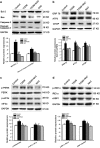Palmitic acid, but not high-glucose, induced myocardial apoptosis is alleviated by N‑acetylcysteine due to attenuated mitochondrial-derived ROS accumulation-induced endoplasmic reticulum stress
- PMID: 29752433
- PMCID: PMC5948205
- DOI: 10.1038/s41419-018-0593-y
Palmitic acid, but not high-glucose, induced myocardial apoptosis is alleviated by N‑acetylcysteine due to attenuated mitochondrial-derived ROS accumulation-induced endoplasmic reticulum stress
Abstract
Pharmacological inhibition of reactive oxygen species (ROS) is a potential strategy to prevent diabetes-induced cardiac dysfunction. This study was designed to investigate precise effects of antioxidant N‑acetylcysteine (NAC) in alleviating diabetic cardiomyopathy (DCM). Echocardiography and histologic studies were performed 12 weeks after streptozocin injection. Protein levels involved in endoplasmic reticulum stress (ERS) and apoptosis were analyzed by western blotting in diabetic hearts or high-glucose (HG, 30 mM)- and palmitic acid (PA, 300 μM)-cultured neonatal rat cardiomyocytes (NRCMs). ROS generation and structural alterations of mitochondria were also assessed. We report that NAC alleviated diabetes-induced cardiac abnormality, including restored ejection fraction (EF %), fraction shortening (FS %), peak E to peak A ratio (E/A) and reduced cardiac hypertrophy and fibrosis. These effects were concomitant with blocked ERS and apoptosis, as evidenced by inactivation of phosphorylated inositol-requiring enzyme-1α (IRE1α)/spliced X-box binding protein 1 (XBP1), phosphorylated protein kinase-like kinase (PERK)/phosphorylated eukaryotic initiation factor 2α (eIF2α) and glucose-regulated protein 78 (GRP78)/activating transcription factor 6 (ATF6α)/C/EBP homologous protein (CHOP) pathways, as well as suppressed Bcl-2-associated X protein (BAX)/B-cell lymphoma-2 (Bcl-2) and cleaved caspase 3 expressions. Mechanistically, PA mediated excessive mitochondrial ROS generation and oxidative stress, which were antagonized by NAC and Mito-TEMPO, a mitochondrial ROS inhibitor. No effects were noted by addition of apocynin, a nicotinamide adenine dinucleotide phosphate (NADPH) oxidase inhibitor, and NADPH oxidase 4 (NOX 4) and NOX 2 expressions were not altered, indicating that PA-induced ROS generation is independent of NADPH oxidases. Most intriguingly, HG failed to promote ROS production despite its ability to promote ERS and apoptosis in NRCMs. Collectively, these findings indicate that NAC primarily abrogates PA-mediated mitochondrial ROS through ERS and therefore alleviates myocardial apoptosis but has little effect on HG-induced cardiac injury. This uncovers a potential role for NAC in formulating novel cardioprotective strategies in DCM patients.
Conflict of interest statement
The authors declare that they have no conflict of interest.
Figures







Similar articles
-
Protein kinase RNA-like endoplasmic reticulum kinase (PERK) signaling pathway plays a major role in reactive oxygen species (ROS)-mediated endoplasmic reticulum stress-induced apoptosis in diabetic cardiomyopathy.Cardiovasc Diabetol. 2013 Nov 2;12:158. doi: 10.1186/1475-2840-12-158. Cardiovasc Diabetol. 2013. PMID: 24180212 Free PMC article.
-
New mechanism of lipotoxicity in diabetic cardiomyopathy: Deficiency of Endogenous H2S Production and ER stress.Mech Ageing Dev. 2017 Mar;162:46-52. doi: 10.1016/j.mad.2016.11.005. Epub 2016 Nov 18. Mech Ageing Dev. 2017. PMID: 27871808
-
[Hydrogen Sulfide Ameliorates Myocardial Injury Caused by Sepsis Through Suppressing ROS-Mediated Endoplasmic Reticulum Stress].Sichuan Da Xue Xue Bao Yi Xue Ban. 2022 Sep;53(5):798-804. doi: 10.12182/20220960106. Sichuan Da Xue Xue Bao Yi Xue Ban. 2022. PMID: 36224681 Free PMC article. Chinese.
-
Decoding cell death signals in liver inflammation.J Hepatol. 2013 Sep;59(3):583-94. doi: 10.1016/j.jhep.2013.03.033. Epub 2013 Apr 6. J Hepatol. 2013. PMID: 23567086 Review.
-
Effects of anticancer drugs on the cardiac mitochondrial toxicity and their underlying mechanisms for novel cardiac protective strategies.Life Sci. 2021 Jul 15;277:119607. doi: 10.1016/j.lfs.2021.119607. Epub 2021 May 13. Life Sci. 2021. PMID: 33992675 Review.
Cited by
-
Effects of Bergamot Polyphenols on Mitochondrial Dysfunction and Sarcoplasmic Reticulum Stress in Diabetic Cardiomyopathy.Nutrients. 2021 Jul 20;13(7):2476. doi: 10.3390/nu13072476. Nutrients. 2021. PMID: 34371986 Free PMC article. Review.
-
Supplementation with aspalathin and sulforaphane protects cultured cardiac cells against dyslipidemia-associated oxidative damage.Metabol Open. 2025 Jan 3;25:100346. doi: 10.1016/j.metop.2025.100346. eCollection 2025 Mar. Metabol Open. 2025. PMID: 39882383 Free PMC article.
-
Qiang-Xin 1 Formula Prevents Sepsis-Induced Apoptosis in Murine Cardiomyocytes by Suppressing Endoplasmic Reticulum- and Mitochondria-Associated Pathways.Front Pharmacol. 2018 Jul 30;9:818. doi: 10.3389/fphar.2018.00818. eCollection 2018. Front Pharmacol. 2018. PMID: 30104976 Free PMC article.
-
Differential expression and inhibitory effects of aquaporins on the development of adenomyosis.Mol Med Rep. 2020 Nov;22(5):3840-3850. doi: 10.3892/mmr.2020.11479. Epub 2020 Sep 2. Mol Med Rep. 2020. PMID: 32901888 Free PMC article.
-
Endoplasmic reticulum stress increases exosome biogenesis and packaging relevant to sperm maturation in response to oxidative stress in obese mice.Reprod Biol Endocrinol. 2022 Nov 21;20(1):161. doi: 10.1186/s12958-022-01031-z. Reprod Biol Endocrinol. 2022. PMID: 36411474 Free PMC article.
References
Publication types
MeSH terms
Substances
LinkOut - more resources
Full Text Sources
Other Literature Sources
Research Materials
Miscellaneous

